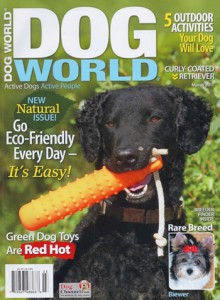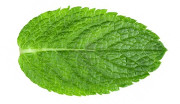 As seen in the March 2011 issue of Dog World magazine.
As seen in the March 2011 issue of Dog World magazine.
Holistic therapies work synergistically with each particular therapy having it’s own strong points. Integrative health care combines the best options from different healing disciplines. Knowing which option or options would work best for your dog’s particular medical problem puts you well ahead in the ‘game of health’.
Backbone Basics
A dog’s backbone can be compared to a horizontal suspension bridge, held up at each end by his hips and shoulders. The vertebral column holds and protects his central communication system called the spinal cord. Nerves branch out from the spinal cord exiting between the vertebrae and communicating to all parts of the body. Acing as a relay center, it both sends and receives information from the brain.
When spinal bones get “stuck” (subluxated) and don’t move correctly they can irritate these delicate nerve branches. This can interfere with the vital “life force” that’s relayed through your dog’s nervous system keeping his brain in touch with his body. When some of the vertebrae in a dog’s spinal column are not in the correct position and nerves become inflamed the muscles will react. Typically they become too tight and sometimes too weak. Discs, ligaments and other connective tissues may become inflamed also.
A sequence of events comes into play when a dog begins to feel discomfort in his back. First of all, his vertebrae are no longer aligned presenting a mechanical problem. In an attempt to stabilize and protect the area, his muscles might tighten or go into a painful spasm. Last of all, the nerves exiting his vertebral column might be compressed and inflamed. Minor back problems if left untreated can escalate into debilitating and dangerous disc problems.
Many people incorrectly use the term ‘slipped disc’. A disc can thin, bulge, rupture or protrude but it doesn’t slip! Each spinal disc has a jelly-like “ball bearing” core that is contained by bands of fibrous tissue. Healthy discs give your dog flexibility, allowing normal turning and bending. Disc protrusion causes extreme pain. With protrusion and rupture, a dog may become paralyzed. A lack of sensation in his hind legs and loss of bowel and bladder control may follow.
Danger Signals
Low-grade back pain acts as a danger signal alerting us to a possible displacement or pinched nerve. Tight painful muscles signal something is wrong, alerting us humans so we can get medical help before things go too far. Our dog’s back may hurt him but he has no way to tell us. I’ve seen many agility and working dogs perform poorly solely due to back pain.
Testing the health and integrity of your dog’s spine is accomplished by softly kneading the muscles on either side of the backbone the entire length of the back. You may find that some of the muscle groups are soft and pliable while one particular area has very tight or even rock-like muscles. A tight area might be out of alignment with a consequent decrease in ability and performance.
Breeds such Dachshunds and Basset Hounds will always be prone to back problems because of their genetic and physical composition. With any breed, jumping and rough housing may cause back injuries.
An Ounce of Prevention is Worth a Pound of Cure
While it’s a good idea to have agility and working dogs adjusted several times a year, tight hard muscles may indicate the need for a quick visit to a chiropractor or veterinary acupuncturist. A simple spinal manipulation and/or acupuncture treatment often nips back problems in the bud. If these therapies are not available in your area, you may want to try Traditional Chinese Herbal Medicine or homeopathic remedies. I’ve found the Chinese herb, Liquidambar 15, from Seven Forests (800-544-7504) to be very helpful. A typical dose would be; Dachshund- one pill three times a day: Basset Hound two pills three times a day: Doberman – three pills three times a day. Spasm Repair, an excellent homeopathic combination remedy, can be obtained from PHP (800-245-1313) with instructions on the bottle.
Learning how to recognize and treat the problem early often prevents more serious back problems. Pain killers and anti-inflammatory drugs may mask the pain but they don’t address the mechanical problem setting the stage for disc disease. In Chapter 8 of my book Dr. Khalsa’s Natural Dog, I write about a Dachshund named Max who, with holistic treatment, smoothly recovers from severe intervertebral disc disease. Spinal manipulation, acupuncture, Chinese herbs and homeopathy can all be used to successfully correct the problem.
Dear Dr. Khlasa,
Maggie is our 10-year old German Shepherd. When she first began dragging her hind feet around we thought it was arthritis. Later on my veterinarian said she has a neurological disease called Degenerative Myelopathy. Sometimes Maggie falls when she turns and she now has trouble getting up. We wonder if there are holistic things we can do to help her.
Cory and Bill
Dear Cory and Bill,
Maggie’s problem lies in her spinal cord. These large nerves are coated by a fatty sheath for protection. Just imagine how an electric cord might short out because it’s plastic coating is damaged. This damage is preventing her brain from communicating quickly with her hind legs. You may have noticed that Maggie initially showed reluctance to go down the stairs. This was because her brain was not getting fast enough feedback on where her hind legs were.
This disease is gradual and progressive but the course of events can often be slowed with holistic intervention. Ask your local veterinarian to check her thyroid because if it is subnormal, supplementation may also help her neurological deficit.
First of all, it’s important to give Maggie regular daily exercise to maximize her muscle tone. Acupuncture has proven helpful with this problem and routine treatments often slow the progress of the disease. Maggie should get an extra 500 IU of Vitamin E and 100 mg of Ubiquinol Co Q 10 every day in addition to a complete and balanced vitamin formula such as Deserving Pets Vital Vites.
Dr. Deva Khalsa, VMD

 About Dr. Khalsa
About Dr. Khalsa